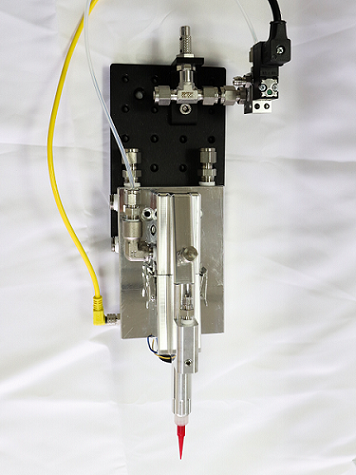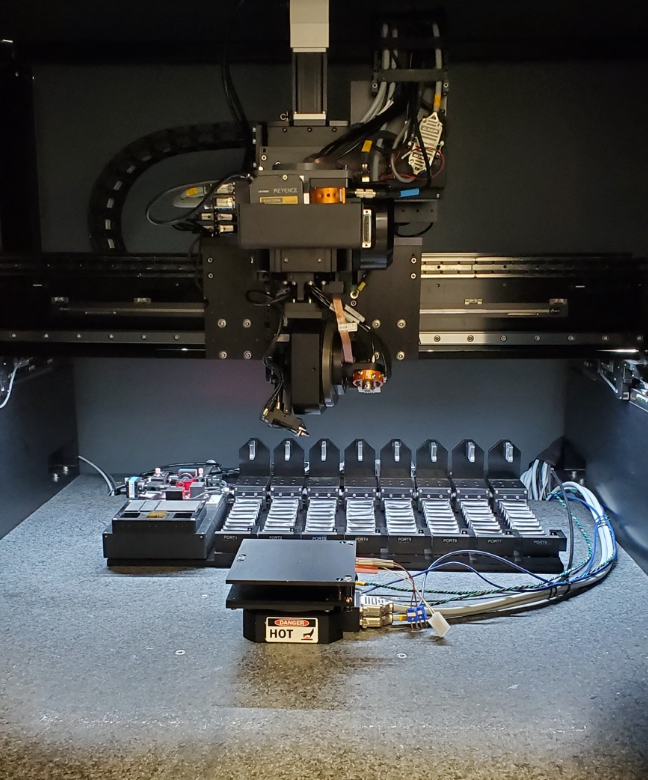Under a Small Business Innovation Research (SBIR) Phase II research grant with the Space Force, Sciperio relied on 3D printers from its sister company nScrypt to make small six unit CubeSats, measuring up to 20 cm × 10 cm × 34.05 cm. More interesting still, these satellites were made entirely inside the 3D printer, specifically an nScrypt Factory in a Tool (FiT) system.
The unique thing about nScrypt´s 3D printers is their ability to feature interchangeable toolheads that can jet, deposit, mill many different types of liquids and solids. This versatility means that the FiT machine could eliminate many conveying and manufacturing steps, while also allowing very quick design iterations and near-automated production. Additionally, this approach can mean that a lot of different components can be made to conform with the geometry of the device, with mass optimized to improve its efficiency. In the case of the the satellite, nScrypt noted:
“[A]fter one layer of the cubesat’s structure is extruded, the system mills that layer to accept an electronic trace and pick-and-placed electronic components that cannot be printed. The extruder then deposits another layer of structure to embed those electronics. That process is repeated until the cubesat is completed, with all of the electronics and other functionality (such as detumbling coils, solar panels, solar sensors, strain gauges, magnetometers, accelerometers, and temperature sensors) embedded into the walls or the surface of the structure itself.”
nScrypt and Sciperio CEO Ken Church stated,
“nScrypt’s FiT provides the ability to rapidly fabricate a small satellite to respond to an immediate need. For example, the Space Force will be able to react rapidly to meet new threats by compressing the time from design to orbit. Sciperio also improves functionality by 3D manufacturing each cubesat as a printed electronic structure. This means that the satellite is not a box with electronics inside. Instead, the functionality is embedded into the structure of the cubesat as it is being digitally manufactured by our system. The design is modular so that functionalities can be interchangeable. Because the system does all of this conformally, the cubesat can be virtually any shape.”
nScrypt’s approach offers a powerful advantage, as launch schedules can be very demanding. By some measures the small satellite market is slated to grow by a factor of four to about 1,700 satellites a year. Assembly cost is very high for satellites. At the same time, there is little in the way of spare capacity. 3D printing most of a satellite within a single 3D printer would be a very valuable capability for helping the satellite industry accelerate its growth. As electronics march forward, more compact components will become more powerful and less expensive. This, in turn, will help to lower the cost and increase the effectiveness of nano- and cubesats. Automated production could also reduce costs significantly.
In the grant itself, the company writes: “By eliminating solder, wire bonds, connector, excess silicon and excess substrate, the possibility exists to shrink an electronic system by more than 100 times. This 100 fold shrinkage will apply to both size and weight and the newly available volume could be applied to power generation and storage.”
We know that components such as waveguides can feature optimized geometry via 3D printing, which would impart further advantages on a process like that of nScrypt. It seems as if the future of our market is becoming tightly intertwined with that of the space industry. The value of 3D printed parts for private space is projected to reach $2.1 billion in 2026, according to the “3D Printing in Commercial Space: The AM Ecosystem in the Private Space Industry” report from SmarTech Analysis. With all of the New Space firms now using 3D printing for their propulsion systems, along with the use of 3D printing by old space firms and defense firms, and the success seen by Optisys and SwissTo12, there is burgeoning growth for additive manufactruing in the space industry. If what nScrypt is doing becomes commonplace, then 3D printing could be an integral part of the production process for a new generation of extremely thrifty and capable nanosats.
Subscribe to Our Email Newsletter
Stay up-to-date on all the latest news from the 3D printing industry and receive information and offers from third party vendors.
You May Also Like
Gorilla Sports GE’s First 3D Printed Titanium Cast
How do you help a gorilla with a broken arm? Sounds like the start of a bad joke a zookeeper might tell, but it’s an actual dilemma recently faced by...
Nylon 3D Printed Parts Made More Functional with Coatings & Colors
Parts 3D printed from polyamide (PA, Nylon) 12 using powder bed fusion (PBF) are a mainstay in the additive manufacturing (AM) industry. While post-finishing processes have improved the porosity of...
$25M to Back Sintavia’s Largest Expansion of Metal 3D Printing Capacity Since 2019
Sintavia, the digital manufacturing company specializing in mission-critical parts for strategic sectors, announced a $25 million investment to increase its production capacity, the largest expansion to its operations since 2019....
Velo3D Initiates Public Offering in a Bid to Strengthen Financial Foundations and Drive Future Growth
Velo3D (NYSE: VLD) has been among a number of publicly traded 3D printing firms that have attempted to weather the current macroeconomic climate. After posting a challenging financial report for 2023,...


































